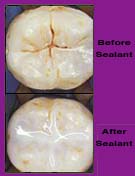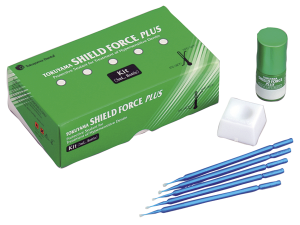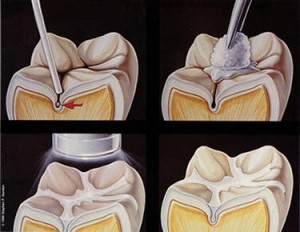
Sealants are essential to prohibiting the harmful expansion of tooth pits
The American Dental Association (ADA) investigates and analyzes all professional aspects of the dental profession, including tooth sealants. According to the ADA website, sealants are essential to prohibiting the harmful expansion of tooth pits, breakages and decay in adults and children. Specifically, studies indicate that dental work of nearly one in three American children between the ages of six and 19 years have undergone sealant coating. The likelihood of developing pit and fissure decay begins early in life, so children and teenagers are obvious candidates for dental sealant application. But adults can benefit from sealants as well.
Dental sealants act as a barrier, protecting the teeth against decay-causing bacteria. The sealants are usually applied to the chewing surfaces of the back teeth (premolars and molars) where decay occurs most often. This plastic resin bonds into the depressions and grooves (pits and fissures) of the chewing surfaces of back teeth. The sealant acts as a barrier, protecting enamel from plaque and acids. Thorough brushing and flossing help remove food particles and plaque from smooth surfaces of teeth. But toothbrush bristles cannot reach all the way into the depressions and grooves to extract food and plaque. Sealants protect these vulnerable areas by “sealing out” plaque and food.
Numerical Grading
A system of numerical grading helps professionals determine how sealants are tested. The grading specification outlines what measures were used during testing and alerts dentists as to the details of the testing process. Grades range from “IA” to “IV.” A grade of Ia—the lowest grade—indicates the sealant was tested only on one or several randomized control trials. Alternatively, a grade of IV—the highest grade, indicates that the product has received reviews from “expert committee reports” and was used in professional clinical work. The rest of the grading between Ia and IV are interpreted as below:
- Grade Ib – Evidence from at least one randomized controlled trial
- Grade IIa – Evidence from at least one controlled study without randomization
- Grade IIb – Evidence from at least one other type of quasiexperimental study, such as time series analysis or studies in which the unit of analysis is not the individual
- Grade III – Evidence from nonexperimental descriptive studies, such as comparative studies, correlation studies, cohort studies and case-control studies
System used for classifying the strength of the recommendations
Clinical recommendations on which dental sealants to be used on the patients were based on the evidence statements were developed. Clinical recommendations were classified according to the strength of the evidence that forms the basis for the recommendation. It is important to note that while the classification of the recommendation may not directly reflect the importance of the recommendation, it does reflect the quality of scientific evidence that supports the recommendation. Because the effectiveness of sealants depends on clinical retention between the tooth surface and the sealants, the panelists chose to accept clinical sealant retention as a reasonable proxy for caries prevention.
- Classification A – Directly based on category I evidence
- Classification B – Directly based on category II evidence or extrapolated recommendation from category I evidence
- Classification C – Directly based on category III evidence or extrapolated recommendation from category I or II evidence
- Classification D – Directly based on category IV evidence or extrapolated recommendation from category I, II or III evidence
Sealant Safeguards
Sealants do more than offer a simple protective coating to prevent cavities, according to the ADA. Sealant coating works to prohibit the formation of non-cavitated carious lesions, a rare but serious occurrence in children. A single sealant coating is designed to protect affected teeth from two to four years without recoating. Furthermore, sealants reduce the manifestation of bacteria by at least 100-fold and lowers the possibility of tooth lesions by half.
Sealant Application
Compatible sealant agents must be used when coating teeth which have experienced previous sealant work. Compatibility protects the enamel of teeth and enhances the effectiveness of older sealant. Both self-etching and acid-etching treatments require a four-handed method for successful application. Additionally, self-bonding sealants demand a dentist to manually etch affected teeth before application to ensure the coating properly bonds.
Sealants are easy for your dentist to apply, and it takes only a few minutes to seal each tooth. The teeth that will be sealed are cleaned (refer to picture 3). Then the chewing surfaces are roughened with an acid solution to help the sealant adhere to the tooth. The sealant is then ‘painted’ onto the tooth enamel, where it bonds directly to the tooth and hardens. Sometimes a special curing light is used to help the sealant harden.
As long as the sealant remains intact, the tooth surface will be protected from decay. Sealants hold up well under the force of normal chewing and usually last several years before a reapplication is needed. During your regular dental visits, your dentist will check the condition of the sealants and reapply them when necessary.

